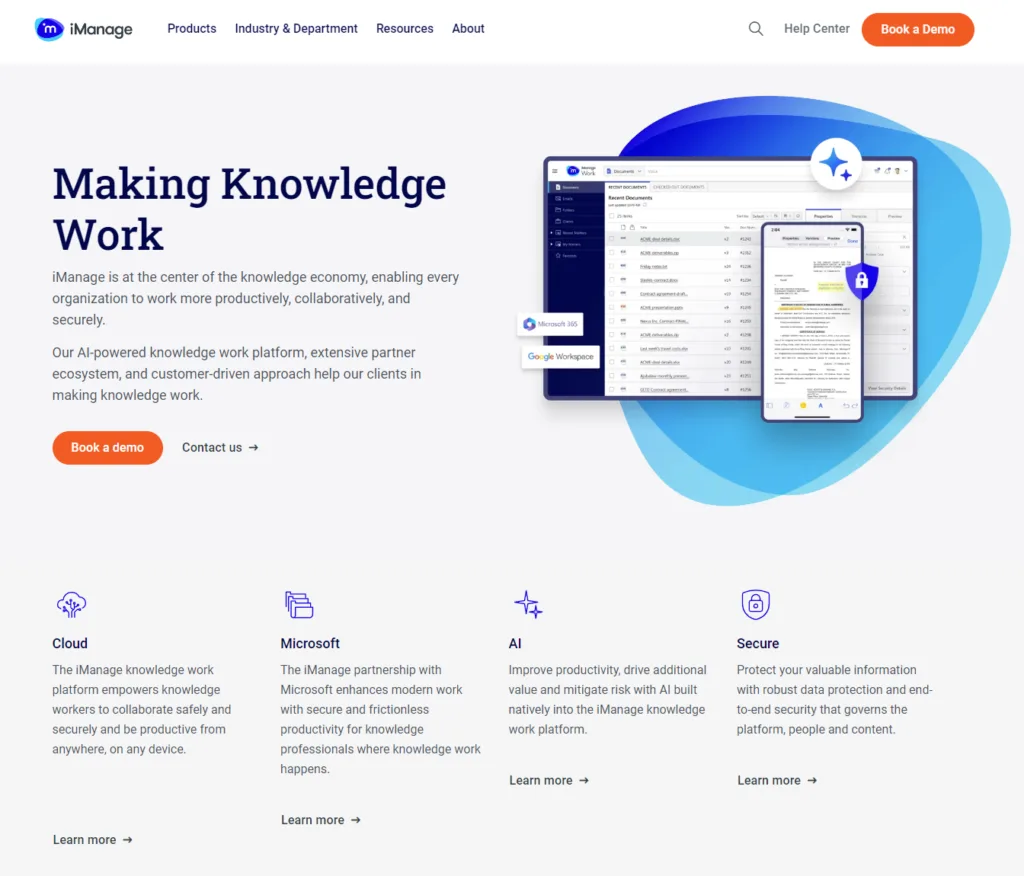Deciding on the right document management tool can be a game-changer for your business operations. Today, we’re pitting Samepage against iManage Work to help you determine which solution might be the best fit for your team’s needs. Each platform has its strengths, tailored to different types of businesses and workflows. Let’s delve into their core features, usability, and how they can streamline your document management processes.
Samepage | iManage Work |
|---|---|
| G2 Score – 4.5 out of 5 stars | G2 Score – 4.3 out of 5 stars |
| TrustRadius Score – 8.1/10 | TrustRadius Score – 8.4/10 |
User Interface and Usability
One of the first things users notice about any software is its user interface (UI) and overall usability. A good document management tool should not only be powerful but also easy to use—this ensures quick adoption and minimal disruption to your daily operations. Let’s take a closer look at how Samepage and iManage Work stand up in these critical areas.
Samepage: Intuitive and Unified Interface
Samepage is designed with simplicity and collaboration in mind. Its user interface is highly intuitive, making it easy for new users to get up and running without extensive training. The platform organizes content into pages and folders that can be easily navigated, and all tools are accessible from a single interface. This simplicity is a major plus for teams that need a solution that integrates both document management and communication tools seamlessly.
One of the standout features of Samepage is its real-time collaboration environment. Team members can edit documents simultaneously, see changes as they happen, and discuss modifications in the context of the document itself, using integrated chat features. This can significantly enhance productivity, especially for teams that are geographically dispersed or working remotely.
iManage Work: Professional and Feature-Rich
iManage Work, on the other hand, is known for its robust feature set designed to meet the needs of professional service firms like law offices, financial institutions, and accounting firms. Its interface is more complex than Samepage’s, reflecting the sophisticated capabilities it offers. Users can manage large volumes of documents and emails efficiently, with powerful search tools that help quickly locate files based on even the smallest details.
While iManage Work is highly effective, its complexity can be a bit daunting for new users. There is a steeper learning curve compared to Samepage, and getting the most out of the platform often requires dedicated training. However, once mastered, it provides unparalleled control over document and email management, making it ideal for industries where document handling is critical to daily operations.
Document Security and Compliance
In any industry dealing with sensitive information, the security features of a document management system are crucial. Both Samepage and iManage Work provide robust security measures, but their approaches cater to different types of organizations. Let’s explore how each platform ensures the security and compliance of your documents.
Samepage: Collaborative Security
Samepage offers a comprehensive set of security features designed to protect documents throughout the collaboration process. It uses industry-standard encryption protocols for both data in transit and at rest, ensuring that all your information is secured against unauthorized access. Additionally, Samepage implements two-factor authentication (2FA), adding an extra layer of security when logging into the platform.
One of the key benefits of Samepage is its ability to set detailed user permissions on documents and folders. This means you can control exactly who can view, edit, or share each document. These permissions are easy to manage and can be adjusted at any time, providing flexibility and control over the flow of information.
Furthermore, Samepage complies with key regulations such as GDPR, making it a viable option for teams that operate within or interact with entities in the European Union. Its compliance features include tools for managing user data and ensuring that document handling processes adhere to necessary legal standards.
iManage Work: Advanced Security for Professionals
iManage Work, tailored more towards the needs of professional service firms, offers a more specialized set of security features. It provides powerful encryption, advanced threat management, and round-the-clock monitoring to safeguard sensitive information. iManage Work’s security is designed to meet the rigorous standards required in legal and financial environments, where client confidentiality and data protection are paramount.
Additionally, iManage Work includes sophisticated compliance tools that help organizations meet industry-specific regulations. Its features support compliance with standards such as HIPAA in the healthcare sector and various finance and privacy regulations globally. iManage Work also offers extensive audit trails that provide detailed logs of all document interactions—essential for maintaining compliance and for conducting thorough audits.
The platform’s security settings are highly customizable, allowing IT teams to set up exacting controls that match the organization’s specific security policies. This level of detail extends to how documents can be accessed, shared, and stored, ensuring that all interactions with sensitive data are meticulously controlled.

Related: Check out our free SEO suite

Integration Capabilities
The ability to integrate seamlessly with other tools and services is a significant consideration when selecting a document management system. It can enhance productivity and streamline workflows by connecting your document management tool with other essential business applications. Let’s examine the integration capabilities of Samepage and iManage Work to see how they complement other software tools.
Samepage: Broad Integration Range
Samepage is particularly strong in its integration with a wide array of third-party applications, which is a boon for teams using diverse tools across their workflows. It offers built-in integrations with popular productivity tools such as Slack, Trello, Google Calendar, and Dropbox. These integrations are designed to create a more cohesive workflow, allowing for the easy transfer of information between platforms and reducing the need to switch between different applications.
In addition to these direct integrations, Samepage can connect to hundreds of other apps via Zapier. This capability extends the platform’s functionality significantly, enabling teams to automate workflows and synchronize data across a broad ecosystem of tools. Whether it’s updating project tasks, sharing files, or syncing calendars, Samepage’s integrations can be customized to fit virtually any operational need, enhancing overall efficiency and team coordination.
iManage Work: Specialized Integration Focus
While iManage Work may not boast as broad a range of integrations as Samepage, it offers deep, specialized integrations that are highly valuable in professional settings. It integrates seamlessly with major office suites like Microsoft Office and G Suite, providing a direct link between document management and the tools most frequently used by professionals like lawyers, accountants, and financial advisors.
iManage Work also offers integrations with email clients such as Outlook, which is particularly important in professional environments where much of the communication and document sharing occurs through email. These integrations are not just surface-level; they allow for sophisticated interaction, such as the ability to save and manage emails and attachments directly within iManage Work, enhancing document traceability and compliance.
Additionally, for organizations that require more customized solutions, iManage Work provides a robust API that allows businesses to develop bespoke integrations tailored to their specific needs. This flexibility is crucial for firms that operate with highly specialized workflows or that need to integrate their document management system with other specialized software used in their industries.
Customer Support and Service Quality
Effective customer support is critical to maximizing the benefits of any document management system, especially when dealing with sophisticated software that plays a central role in business operations. Here, we will evaluate the support services of Samepage and iManage Work to see how well they assist their users in resolving issues and optimizing system use.
Samepage: Accessible and Community-Driven Support
Samepage prides itself on providing accessible and responsive customer support. It offers a variety of support channels including live chat, email support, and an extensive online help center that features detailed guides, FAQs, and instructional videos. These resources are designed to help users understand and utilize all features of the platform effectively, ensuring a smooth user experience.
In addition to standard support channels, Samepage has a strong community forum where users can share tips, ask questions, and provide feedback about the platform. This community-driven approach not only helps users solve common problems but also fosters a sense of collaboration among users, which can be very beneficial for discovering innovative uses of the platform and best practices.
iManage Work: Professional and Specialized Support
iManage Work offers a more tailored support experience, suitable for the professional environments in which it is used. Its customer support includes 24/7 technical support for critical issues, ensuring that firms can rely on the system around the clock. iManage also provides dedicated account managers and customer success teams to larger clients, which helps ensure that the platform is aligned with the firm’s specific needs and that any issues are resolved quickly and efficiently.
Furthermore, iManage Work conducts regular training sessions and has a comprehensive knowledge base that includes user manuals, how-to articles, and troubleshooting guides. These resources are particularly detailed, reflecting the complex nature of the software and the professional settings in which it is used.
Pricing Models and User Reviews
Understanding the pricing structures and user feedback for document management systems is crucial when selecting the right tool for your business. Let’s take a closer look at how Samepage and iManage Work are priced and what users are saying about their experiences with these platforms.
Samepage: Flexible Pricing and Positive User Feedback

Samepage offers a tiered pricing model that caters to teams of all sizes, from small businesses to large enterprises. It provides a free version with basic features, which is great for small teams or startups looking to get a feel for the platform without committing financially. For more advanced features, Samepage has several paid plans, which include additional collaboration tools, more storage, and advanced administration options. The pricing is competitive and scales well with the size of the team and the breadth of features required.
User reviews of Samepage often highlight its user-friendly interface and the effectiveness of its real-time collaboration features. Many users appreciate the integrated approach to communication and project management, noting that it helps keep teams synchronized and productive. Additionally, the responsive customer support and robust community forums are frequently mentioned as valuable resources for troubleshooting and learning.
iManage Work: Enterprise-Level Pricing and Specialized User Feedback

iManage Work, being targeted primarily at professional services firms like legal, financial, and accounting sectors, generally comes with a higher price tag. Its pricing model is designed to reflect the specialized nature of the tools it offers, including advanced document and email management, compliance features, and robust security measures. The platform typically does not offer a free version, focusing instead on providing comprehensive paid packages that include extensive support and training services.
User reviews for iManage Work often emphasize its robust capabilities in handling large volumes of documents and its powerful search and organization features. Many users from legal and financial backgrounds praise the platform for its ability to manage complex document workflows and maintain strict compliance with industry regulations. However, some reviews also point out the steep learning curve and the need for initial training to fully leverage the platform’s features.
Conclusion
Deciding between Samepage and iManage Work for your document management needs hinges on understanding the specific requirements of your organization and how these platforms align with those needs.
Samepage shines in its user-friendly interface, flexible pricing, and strong collaborative features, making it ideal for small to medium-sized businesses or teams that value integrated communication and project management within a single platform. Its affordability and ease of use are significant advantages for those looking for a straightforward, versatile tool.
iManage Work, on the other hand, is tailored for professional services firms in fields such as law, finance, and accounting, where advanced document management, security, and compliance capabilities are critical. Although it comes with a higher cost, its specialized features support complex, high-stakes environments requiring meticulous document control and regulatory adherence.
Read Next:
- GetResponse vs Zoho Campaigns: The Best Email Marketing Tool for 2024
- AWeber vs ActiveCampaign: The Best Email Marketing Tool
- Constant Contact vs Campaigner: Best Email Marketing Tool
- GetResponse vs Omnisend: The Best Email Marketing Tool for 2024
- AWeber vs Benchmark Email: The Best Email Marketing Tool






















Comments are closed.